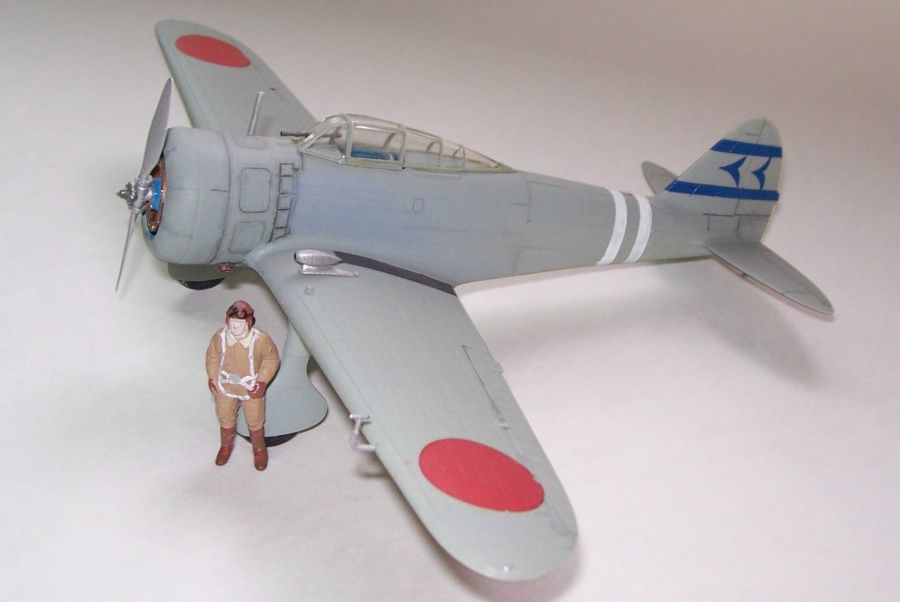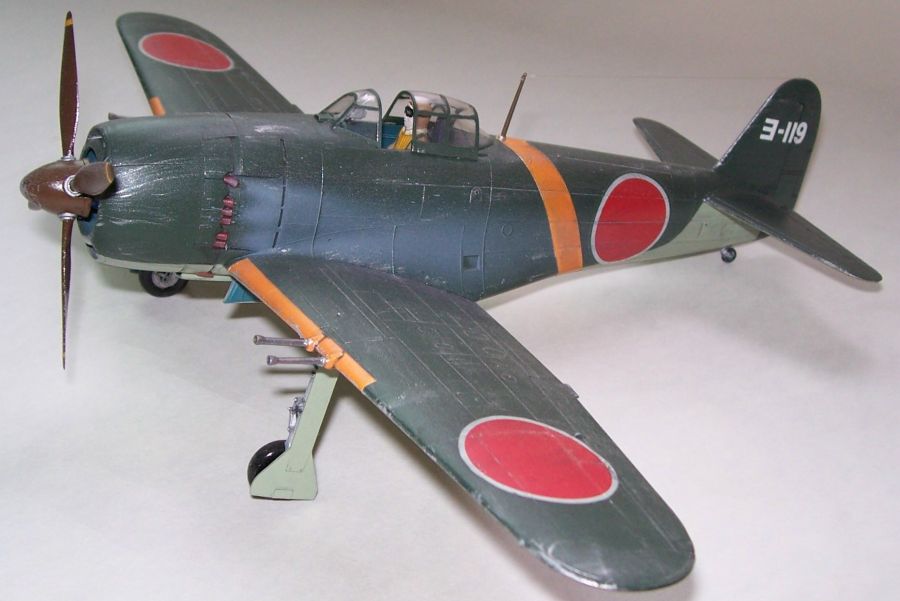
They’re All Zeros
By Scott Kruize
Rearranging my display shelves to accommodate the Eduard F6F ‘Hellcat' brought me back to all the ‘Zeros' I've modeled since returning from the Dark Ages…
[Speaking of Zeros, what did the crew chief at the Japanese naval air base yell, in pidgin Japanese/English, at his good-for-nothing mixed-ancestry work crew, when he found them lying around lazily, instead of cleaning up the dirty, dusty fighter planes?]
When I started modeling at age 11, of course I "knew" about the Zero, as the only Japanese fighter of WWII…just like I "knew" about the Spitfire, the only British fighter…
So among my very first builds was the Aurora Zero. It was molded in bright shiny yellow.

I wrote the column "Messerschmitts are Purple" about how those fantastic plastic molded-in colors have affected me to this day. I have to exercise tight mental control not to visualize the real things in Aurora plastic colors.

The year before I started modeling, my grandparents gave me Robert Scott's God Is My Co-pilot. Great book: just the kind of high-flying adventure young boys really get into. I'll bet you readers remember the excitement of reading about the dogfights he and the guys of the Flying Tigers and 14th Air Force fought against Zeros, always named as such. Of course, in real life neither force ever encountered a single Zero, engaged as they were against the Japanese Army, not the Navy. (General Chennault saw the preproduction batch in their live-fire ‘tests' over China during the summer of 1940, but they were long gone before he could form up the Flying Tigers.) Their opponents were Nakajima Ki.27s and Ki.43s.


I didn't even grasp this point till the Now, once I started hanging around with the NorthWest Scale Modelers and Seattle IPMS, and greatly increasing the amount and quality of my research into modeling subjects.
Even back Then, though, I soon realized they really WEREN'T all Zeros. David Cooke's Fighter Planes That Made History had pages on the Kawasaki ‘Hein' and the Kawanishi ‘Shiden'. Then the Kent Public Library introduced me to William Green's series of books, Warplanes of the Second World War. They had volumes One and Four, covering fighters of Germany and the U.S., and I was in Seventh Heaven paging through them: so MANY different killer cool fighter planes! Then, at the Gov-Mart in Renton, the book section had Volume 4 (Great Britain and Italy) and Volume 3 (the U.S.S.R. and Japan). These were the first aviation reference books I ever bought…the ancient, tiny beginnings of the current ‘Hurricane Bookshelf' I write about for the Seattle IPMS. I Now have some four to five hundred aviation-related publications on it, or roughly one book for each kit in my ‘stash'!
Those two volumes hold ‘Pride of Place' on my shelves, but they now fit into a lineup of the whole set. When I learned about eBay, and saw that even the most obscure books traded there, the first task I set myself was to gather all the Warplanes of the Second World War. I succeeded, and still take pleasure, from time to time, paging through all the fighters of this or that combatant. Lots of ‘Zero' stablemates in Volume 3!

But back to Then. I was at least enough educated to recognize and snap up two other Japanese fighters when I encountered them. Having started on the Airfix/72 line, I'd decided to confine all my purchases to that scale. Of course I built Airfix's own ‘Zero'. But then I got the Revell Authentic Kit of the Kawasaki ‘Hein', and then the ‘Pacific Sky Fighters' set, which included the ‘Army Zero', the Nakajima Ki.43 Hayabusa, in Thai insignia. The former came out rather well, I thought. Since I started on the Airfix line, all molded in plain silver-gray, I was learning to paint. The Hein got a green irregular dabble camouflage scheme over its silver base. The Hayabusa was to be finished in green, brown, and gray, a unique Thai scheme. I never got around to building it back Then, and can't recall why.

I've tried making up for this failure in the Now. A run of several months saw me build almost all the operational Japanese WWII fighters, the ‘Zeros' in their many forms. I took this collection to Pierce College once, to add to the displays in support of "World War Two Week", with its lectures and presentations. Ken Murphy works at Pierce, encouraged me to participate, and introduced me to the Event's prime organizer. He actually had an interesting take on why non-experts think all the Japanese fighters (actually, all Japanese aircraft) are Zeros: "They're all marked with those big red ‘meatballs', which look like zeros."

While we're laughing at such innocence, note that a recent Hobby Surplus mail-order catalog had a section entitled:
#ARI00325 Kawasaki Ki.100
#ARI00327 Nakajima Ki.84 ‘Hayate’
#ARI00328 Nakajima Ki.44 ‘Shoki’
Illustrated, of course, with a Zero.
Well, if they're all Zeros, then besides the actual Mitsubishi ‘Rei-Sen', I've built the Army Zero, the Fixed-gear Zero, the Pointy-Nosed Zero, the Portly Zero, the Humungous Thunderbolt-ish Zero, the Stubby Climbing Demon Zero, the Svelte-and-Speedy Zero, the Political Pawn Zero, the Float Zero, and the Lash-up Or Improvised Zero. I know my sophisticated readers know the correct designations for all these.








I kinda ‘burned out' on doing these awhile back, and turned to other projects. But I'll resume adding to the lineup in the not-too-distant future. I still have to do at least two ‘Twin-engined Zeros', plus the ‘Gee Bee Zero', the ‘Float Zero on Steroids', the ‘Canard Zero', the ‘Hurricane Zero', and of course the ‘Jet Zero' and ‘Rocket Zero'. (Wouldn't these last four, of planes that didn't' quite have time to get into service, make great ‘Luft-46'-type projects? Why should all the speculative 1946 warplanes be Nazi German?!)
My stash already includes kits for most of these, and I'm sure I'll acquire the others at upcoming Shows and Swap Meets. In other words, the material will be in hand to continue our Calling, namely to
BUILD WHAT YOU WANT, THE WAY YOU WANT TO, AND ABOVE ALL, HAVE FUN!
[The crew chief shouted, "Rei-Sen shine!"]

